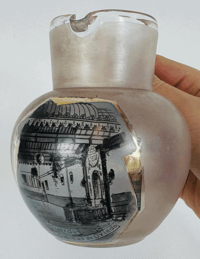

|
| ESPAÑA | Spain |
| Principado de Asturias | Principality of Asturias |
Oviedo, the capital of the Spanish autonomous region Principality of Asturias is situated at an elevation of 231 m just north of the river Nalón in the centre of the region. At a population of about 220,500 (2024) it is the second most populated city of Asturias after Gijón.
The Kingdom of Asturias began in 720, with the Visigothic aristocrat Pelagius's (685–737) revolt against the Muslims who at the time were occupying most of the Iberian Peninsula. The resulting Kingdom of Asturias, located in an economically poor region of Iberia, was largely ignored by the Muslims. It is said that two monks, Maximus and Fromestanus, founded the city in 761. Following Pelagius, who died in 737, Alfonso I founded a dynasty that reigned until 1037. The intention with Oviedo was to shape it into a city similar to that of Visigothic Toledo. After the death in 910 of Alfonso III, 'the Great', the roal court was moved to León. During the 12th century, many Royal Charters were fabricated by bishop Pelayo de Oviedo, "el fabulador" ("the fabulist"). the bishop's intent behind this was to try to gain the independence of his see from the archbishops of Toledo and Santiago de Compostela, as well as to promote Oviedo as a pilgrim destination. The following centuries (12th–16th) witness the development of the medieval city, the outlines of which are still preserved today, the construction of the city walls, a devastating fire which took place on Christmas Eve in 1521, and the aqueduct works, Los Pilares, constructed in order to provide the city with water throughout the 16th century. The foundation of the Arts College (University of Oviedo) at the beginning of the 17th century opened Oviedo to a progressive urban expansion. Further impulse was in the 18th century by the regional nobility and the construction of remarkable palaces; in the 19th century by industrial growth and the suburban development, and finally in the 20th century by administrative and commercial development. The "Monuments of Oviedo and the Kingdom of the Asturias" have been listed as UNESCO World Heritage Sites in 1985.

The spa  Las Caldas de Oviedo [left, no. 0000] is located in the community Las Caldas,
which is part of the municipality of Oviedo and is located about 7 km southwest of Oviedo's centre. The complex, built in 1776, was taking
advantage of the thermal watres rich in carbonates and trace elements, with a temperature of 40°C. It became an important spa destination
during the 18th century, primarily for rheumatism. The spa complex consists of a three-story bathhouse, a guest hotel, and medical facilities.
Las Caldas de Oviedo [left, no. 0000] is located in the community Las Caldas,
which is part of the municipality of Oviedo and is located about 7 km southwest of Oviedo's centre. The complex, built in 1776, was taking
advantage of the thermal watres rich in carbonates and trace elements, with a temperature of 40°C. It became an important spa destination
during the 18th century, primarily for rheumatism. The spa complex consists of a three-story bathhouse, a guest hotel, and medical facilities.
[https://de.wikipedia.org/wiki/Oviedo, https://en.wikipedia.org/wiki/Oviedo;
https://es.wikipedia.org/wiki/Balneario_de_Las_Caldas]
![[scale]](lineal.jpg)